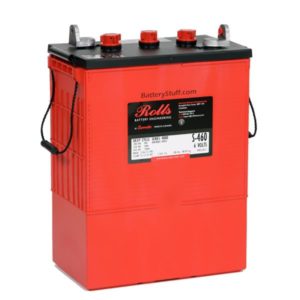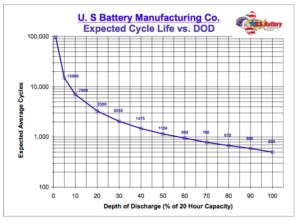Batteries are the heart of an off-grid system, so it is critical to take care of your batteries.
If you are not careful in managing and caring for your batteries, then you can shorten their lifespan substantially.
There are three major keys to extending the life of your lead-acid batteries:
1. Battery Maintenance
For typical flooded lead-acid batteries ensure the following:
Battery watering
- Water levels should be checked on a regular basis. This interval will vary from system to system, but with a new system, we recommend checking at least once a week until a required interval is established.
- Use distilled water only. Normal tap water can contain minerals that will reduce the life of your batteries
- Electrolyte levels should never get low enough to expose the lead plates in the batteries. If you notice the plates are exposed, add distilled water immediately.
- Do not overfill your batteries. The most common mistake we see with system owners is overfilling. The maximum electrolyte level is approximately 1/4” to 1/2” below the vent well tube which extends down into the battery. If you ever notice liquid on top of your batteries, this typically an indication that you are overfilling them. When this happens, valuable electrolyte is lost which reduces the lifespan of your batteries. This also promotes corrosion. Lastly, we recommend adding distilled water when the batteries are at a full-charge. The electrolyte level within the battery can rise during the process of charging, so filling at a full charge will prevent overflow.

- If you don’t think you’ll be willing to water your batteries on a regular basis, then we recommend the more expensive sealed maintenance-free lead-acid batteries like AGM or Gel.
- Keep battery terminal clean and free of corrosion. Corrosion can cause resistance in your battery connections and reduce the even flow of electrons throughout the bank. This can cause your batteries to charge unevenly and reduce their lifespan. You can use store-bought battery cleaner or baking soda to clean battery terminals, being careful not to get any inside the cells of the battery. A wood-handled wire brush can also be used to get more stubborn levels of corrosion. Once your terminals are clean, we recommend using battery terminal protectant to prevent further corrosion.
- Periodically check your battery interconnect cables to ensure they are tight. Loose cables can cause a number of problems.
2. Prevent discharging your batteries too far.
The deeper you discharge your batteries, the shorter their lifespan will be. The general rule for solar-electric systems is to prevent discharging your batteries more than 50%. This typically equates to roughly 12.0 Volts on a 12V nominal system under a small load. We recommend a good battery monitor to more easily determine your battery state-of-charge. Most inverters are designed to shut down if the battery voltage gets too low in order to prevent damage to the batteries. This is called the Low Voltage Disconnect(LVD). Make sure to adjust your LVD settings on your inverter to prevent over discharging your batteries.
3. Ensure the batteries return to a full charge on a regular basis.
Ideally, we recommend that your batteries reach a full-charge every day, however, returning your batteries to 100% full at least once a week will prevent battery sulfation and extend the life of your batteries. If the solar is not providing enough charging to accomplish this, then it will be necessary to use the generator as often as needed to provide the balance. It can sometimes be difficult to determine if your batteries are reaching 100% state-of-charge, that is why we recommend a good battery monitor. Additionally, if your solar charge controller has reached the “float” stage of charging, this is generally a good indication that the batteries have reached a full charge. However, you must verify that the charge controller has been set up properly for the size and type of your battery bank.


